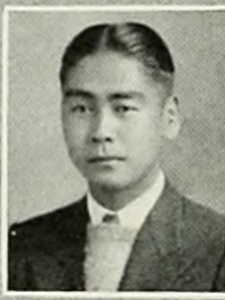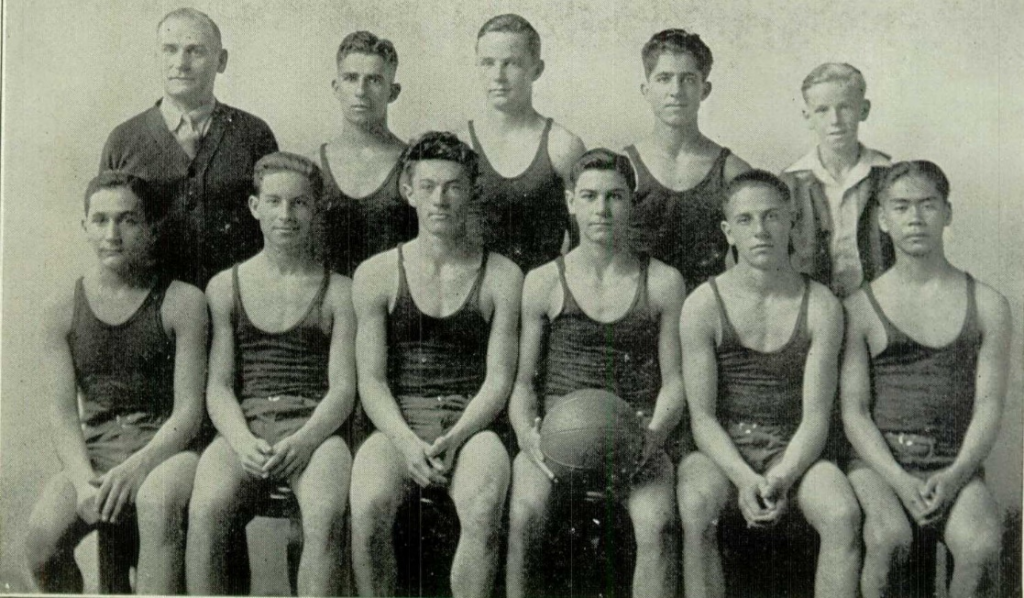
Fred Shigeo Yasuda
Private First Class
442nd Regimental Combat Team
3rd Battalion, K Company
Fred Shigeo Yasuda was born on June 3, 1912, in Los Angeles, California, to Hikokichi Frank and Shigeko (Okawara) Yasuda. He was one of four children: brother Jerry Minoru, and sisters Hanako and Peggy Aiko. Hikokichi emigrated from the city of Hiroshima, Hiroshima Prefecture, Japan, arriving in 1904. He returned to Japan and married Shigeko in 1905. Shigeko emigrated in 1907.
In 1910, Hikokichi was working odd jobs; by 1917, he was working for a creamery located at 241 Winston Street in Los Angeles. The family was living at 308 East 4th Street. In 1930, he was working as a clerk in a department store, and living at 519 East 4th Street. By 1940, he had retired and was living at 631 Stanford Avenue, Los Angeles.
Fred graduated in 1933 from Polytechnic High School in Los Angeles. He excelled in sports and was on the All-City Lightweight Basketball City Championship Team in 1931, and chosen for the All-City Squad. He also was on his high school Class B (Lightweight) Basketball team.

Above: 1931 high school basketball team; Fred is front row, far right
Yasuda registered for the draft on October 16, 1940, at Local Board No. 216 in Los Angeles. He was working for J. W. Robinson at 7th and Grand Avenue. His point of contact was his father, and he was living with his family at 631 Stanford Avenue. Fred was 5’7½” tall and weighed 168 pounds.
In the spring of 1942, he and his parents were evacuated to the Wartime Civil Control Administration (WCCA) Assembly Center at Santa Anita Racetrack. On October 3 they were incarcerated at the Rohwer WRA Relocation Center in Arkansas. They lived at Quarters 17-6-F. Fred was released on April 29, 1943, and enlisted in the Army in Little Rock, Arkansas. At that point, he had completed one year of college. He was sent to Camp Shelby, Mississippi, where he was assigned to the 442nd Regimental Combat Team, 3rd Battalion, K Company.
Fred returned to the Rohwer Relocation Center and married Shizue Vivian Okita on December 28, 1943, in Pulaski County, Arkansas, about 100 miles from Rohwer. Shizue, the daughter of Tatsugoro and Kaoru Akita, was born in Multnomah County, Oregon, but was living with her family in Torrance, Los Angeles County, by 1935. She and her family had entered Rohwer from the Santa Anita WCCA Center on the same day as the Yasuda family. She was living in Quarters 1-12-A. Shizue was released from Rohwer on March 15, 1944, for employment in Chicago, Illinois.
After a year of basic and unit training, the 442nd left Camp Shelby for Camp Patrick Henry, Virginia, on April 22, 1944. They shipped out to the Mediterranean Theater of Operations in a convoy of over 100 ships on May 2, and arrived at Naples, Italy, on May 28.
Fred fought in the Rome-Arno Campaign. The 442nd entered combat near Suvereto on June 26, 1944. After three months pursuing the enemy north toward the Arno River, the 442nd was sent to France. He went with his unit as they were sent to Marseilles, France, on September 27 to join in the Rhineland-Vosges Campaign.
After arriving in France, Third Battalion was moved from the staging area in Septèmes, just outside Marseilles, on October 10, by rail up the Rhone Valley north to the Vosges. The train was an assortment of “40 and 8” boxcars. They arrived in the assembly area at Charmois-devant-Bruyères at midnight on October 13.
At 2:00 p.m. the next day the Combat Team began moving into position to attack the important rail and road center of Bruyères the following morning. After several days of intense fighting, the enemy had been cleared from the town and its surrounding hills, and on October 23 the 442nd was ordered to take the next town, Biffontaine. Finally, on October 24, they were taken off the front lines and put in reserve in nearby Belmont for a rest after eight days of heavy fighting, little to no sleep, harsh weather conditions in their summer uniforms, and many casualties.
In the afternoon of October 26, the short rest was abruptly ended when the 442nd was ordered to go into the lines the next morning and fight through to rescue the “Lost Battalion,” the 1st Battalion of the 141st (Texas) Infantry Regiment. After moving too fast and over-reaching its support, they had become surrounded on three sides by the enemy and were unable to extricate themselves. The 2nd and 3rd Battalions of the 141st Infantry Regiment had tried to rescue them along with other units, but were thrown back each time they attacked.
The Combat Team set out from Belmont on October 27 and encountered several days of severe fighting. Two days later, while engaged with the enemy, his actions warranted a Bronze Star Medal. The Citation reads as follows:
For heroic achievement on 29 October 1944 in the vicinity of Biffontaine, France. The ammunition supply of his rifle company having become depleted, Private Yasuda voluntarily left his cover and crawled 40 yards under intense enemy fire to remove ammunition from the wounded and distribute it among the riflemen. The supply being insufficient, he again exposed himself to the enemy fire to make his way back to the ammunition pile for a resupply. He then returned to the lines, distributed his ammunition, and voluntarily remained on the firing lines as a rifleman. Private Yasuda was killed in a subsequent engagement with the enemy.
Next of kin: Mrs. Shizue V. Yasuda (Wife), 1-12-A, Rohwer Relocation Center, McGhee, Arkansas.
On October 30, the Lost Battalion was rescued. It came at great loss for the 442nd, with very high casualties. K Company had lost all of its officers, I Company had only eight riflemen remaining, while K Company was down to only 25 riflemen. The normal, full-strength complement consists of 150 riflemen in a company.
The initial objective of the Texas Lost Battalion had been to clear the Germans from the entire long ridge of mountain where it had become surrounded – and the 442nd’s 3rd Battalion was ordered to push on down to the end of this ridge.
The following day, November 1, 1944, Private First Class Fred Shigeo Yasuda was hit in his back by an artillery shell and killed. The fighting would go on until November 9. The German line was completely shattered, but 442nd losses were so great that the Combat Team was temporarily ineffective as a fighting force.
Pfc. Fred Yasuda was buried in the U. S. Military Cemetery in nearby Epinal, France.
For his military service, Private First Class Fred Shigeo Yasuda was awarded the Bronze Star Medal with one oak leaf cluster, Purple Heart Medal, Good Conduct Medal, American Campaign Medal, World War II Victory Medal, Distinguished Unit Badge, and Combat Infantryman Badge. Fred was awarded the Congressional Gold Medal on October 5, 2010, along with the other veterans of the 100th/442nd Regimental Combat Team. This is the highest Congressional Civilian Medal.
Fred Yasuda’s parents were released from Rohwer WRA Relocation Camp on November 16, 1945, to return to Los Angeles.
In 1948, the Yasuda family had the choice to have Fred returned to the US or remain at Epinal, which was a major U.S. Military Cemetery. They chose to bring him home. On December 31, 1948, Yasuda was among the 4,384 war dead whose remains returned to the US on the USAT Barney Kirschbaum. The ship was delayed several days due to a heavy storm at sea. It arrived at Pier 3, Brooklyn Army Base in New York Harbor. Several hundred people attended a memorial service held dockside, officiated by Judge Advocate General Arthur Levitt of the New York Port of Embarkation.
Pfc. Fred S. Yasuda was interred in the 442nd RCT Section of Evergreen Cemetery, Los Angeles.
On October 30, 1949, the Young Buddhist Association of Los Angeles held the first National Nisei Memorial Day with a special religious ceremony at 10:30 a.m. at the Nishi Hongwanji Temple, 119 North Central Avenue. A military ceremony followed at Evergreen Cemetery, 204 North Evergreen Avenue. The occasion was the fifth anniversary of the rescue of the Lost Battalion in the Vosges. A bronze plaque at the Temple contains the sixteen names of fallen soldiers from the Los Angeles area, including the name of Fred Shigeto Yasuda.
Postscript. On March 8, 1946, Fred’s widow, Shizue Vivian Yasuda, married Roy S. Morita in Chicago. She died in Chicago on March 9, 1983. Survivors included her husband and one son. She was buried at Acacia Park Cemetery in Chicago.
Researched and written by the Sons & Daughters of the 442nd Regimental Combat Team in 2022.
